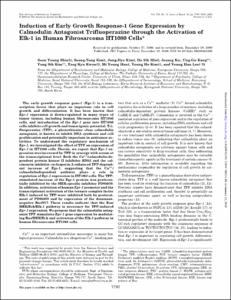Induction of Early Growth Response-1 Gene Expression by Calmodulin Antagonist Trifluoperazine through the Activation of Elk-1 in Human Fibrosarcoma HT1080 Cells
- Affiliated Author(s)
- 권택규
- Alternative Author(s)
- Kwon, Taeg Kyu
- Journal Title
- Journal of Biological Chemistry
- ISSN
- 0021-9258
- Issued Date
- 2001
- Abstract
- The early growth response gene-1 (Egr-1) is a transcription factor that plays an important role in cell growth and differentiation. It has been known that Egr-1 expression is down-regulated in many types of tumor tissues, including human fibrosarcoma HT1080 cells, and introduction of the Egr-1 gene into HT1080 cells inhibits cell growth and tumorigenic potential. Trifluoperazine (TFP), a phenothiazine class calmodulin antagonist, is known to inhibit DNA synthesis and cell proliferation and potentially important in antitumor activities. To understand the regulatory mechanism of Egr-1, we investigated the effect of TFP on expression of Egr-1 in HT1080 cells. Herein, we report that Egr-1 expression was increased by TFP in synergy with serum at the transcriptional level. Both the Ca21/calmodulin-dependent protein kinase II inhibitor KN62 and the calcineurin inhibitor cyclosporin A enhanced TFP-dependent increase of Egr-1, suggesting that the Ca21/calmodulindependent pathway plays a role in regulation of Egr-1 expression in HT1080 cells. The TFPstimulated increase of the Egr-1 protein was preferentially inhibited by the MEK-specific inhibitor PD98059. In addition, activation of human Egr-1 promoter and the transcriptional activation of the ternary complex factor Elk-1 induced by TFP were inhibited both by pretreatment of PD98059 and by expression of the dominantnegative RasN17. These results indicate that the Ras/MEK/Erk/Elk-1 pathway is necessary for TFP-induced Egr-1 expression. We propose that the calmodulin antagonist TFP stimulates Egr-1 gene expression by modulating Ras/MEK/Erk and activation of the Elk-1 pathway in human fibrosarcoma HT1080 cells. Ca21 is an important intracellular messenger in many biological processes. Calmodulin is a ubiquitous Ca21-binding protein that acts as a Ca21 mediator (1). Ca21-bound calmodulin regulates the activities of a large number of enzymes, including calmodulin-dependent protein kinases (CaMK)1 such as CaMK-II and CaMK-IV. Calmodulin is involved in the Ca21-mediated regulation of gene expression and in the regulation of cellular proliferation process, including DNA synthesis and cell cycle progression (2–6). It has been reported that the calmodulin level is elevated in several tumor cell lines (3, 7). Moreover, in vivo treatment with calmodulin antagonists has been shown to reduce tumor size (8), indicating that calmodulin plays an important role in control of cell growth. It is now known that calmodulin antagonists are cytotoxic against tumor cells and can restore sensitivity to drug-resistant cells, thus addressing the possibility that calmodulin antagonists may be valuable chemotherapeutic agents in the treatment of certain cancers (9, 10). However, little information is available regarding the mechanisms responsible for regulation of cell growth by calmodulin antagonists. Trifluoperazine (TFP) is a phenothiazine derivative antipsychotic drug. TFP is a well known calmodulin antagonist that has been used for studying the function of calmodulin (11, 12). Previous reports have demonstrated that TFP inhibits DNA synthesis and cell proliferation and, thereby, is potentially an important antitumor agent, as well as having antipsychotic properties (13). The product of the early growth response gene Egr-1 (14), which is also known as NGFI-A (15), zif268 (16), krox24 (17), or Tis8 (18), is a transcription factor that has three Cys2-His2-type zinc finger-containing DNA binding domains in the Cterminal portion of the molecule. Egr-1 preferentially binds to GC-rich regulatory elements with the consensus sequence of GCGGGGGCG or TCCTCCTCCTCC (16, 19), leading to induction or repression of its target genes. It has been demonstrated that Egr-1 is important in regulating cell growth, differentiation, and development (20). Expression of Egr-1 is significantly reduced in a number of tumor cells (21, 22), and loss of expression is closely associated with tumor formation in mammalian cells and tissues (22). On the other hand, stable expression of Egr-1 inhibited cell proliferation and soft agar growth in NIH3T3 cells transformed with v-sis, indicating that Egr-1 functions as a tumor suppressor (23). We examined the effect of TFP on expression of the tumor suppressor Egr-1 in human fibrosarcoma HT1080 cells. Our results revealed that treatment of cells with serum and TFP increased levels of both mRNA and the protein of Egr-1. The increment was associated with the increase of Egr-1 promoter activity through activation of the ternary complex factor (TCF) Elk-1.
- Department
- Dept. of Immunology (면역학)
- Publisher
- School of Medicine
- Citation
- Soon Young Shin et al. (2001). Induction of Early Growth Response-1 Gene Expression by Calmodulin Antagonist Trifluoperazine through the Activation of Elk-1 in Human Fibrosarcoma HT1080 Cells. Journal of Biological Chemistry, 276(11), 7797–7805. doi: 10.1074/jbc.M009465200
- Type
- Article
- ISSN
- 0021-9258
- Appears in Collections:
- 1. School of Medicine (의과대학) > Dept. of Immunology (면역학)
- 파일 목록
-
-
Download
 oak-aaa-4495.pdf
기타 데이터 / 483.84 kB / Adobe PDF
oak-aaa-4495.pdf
기타 데이터 / 483.84 kB / Adobe PDF
-
Items in Repository are protected by copyright, with all rights reserved, unless otherwise indicated.